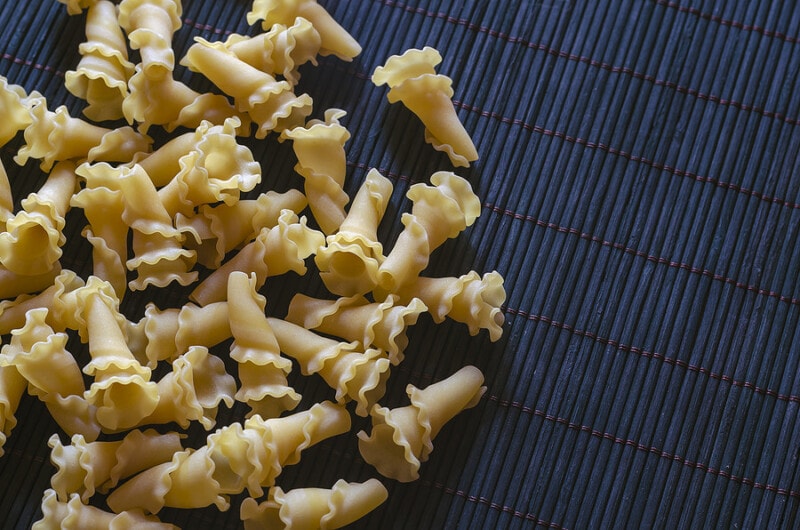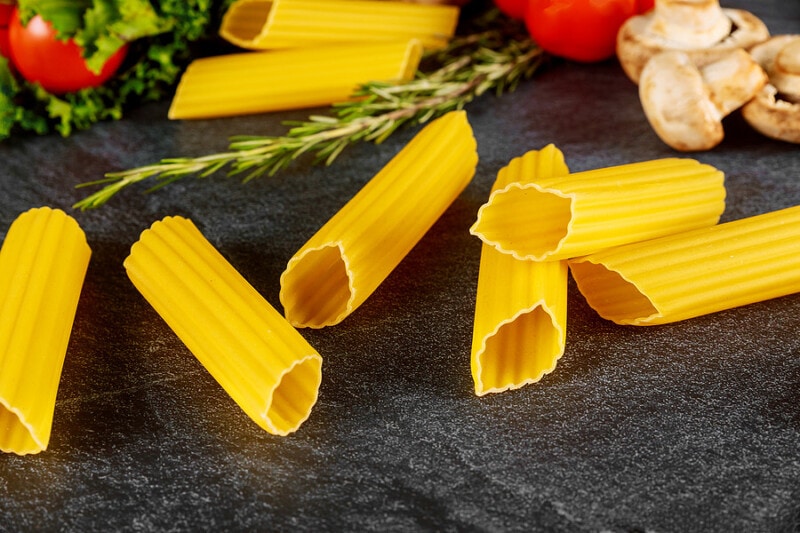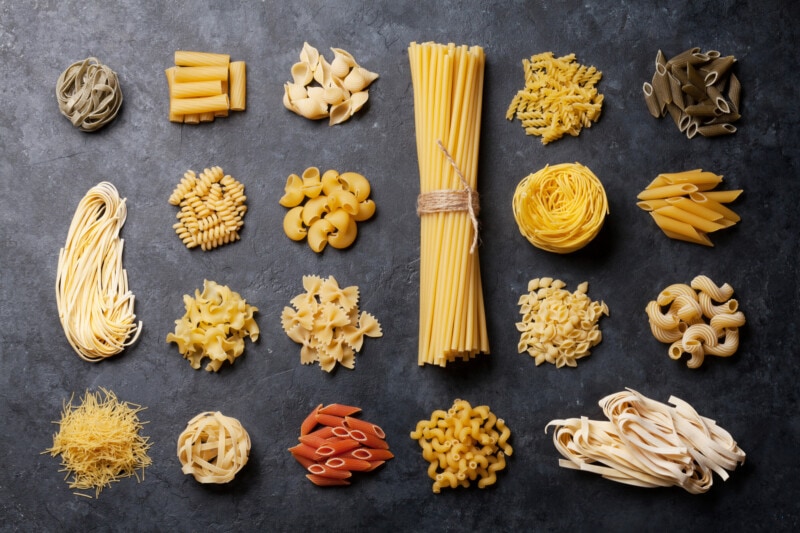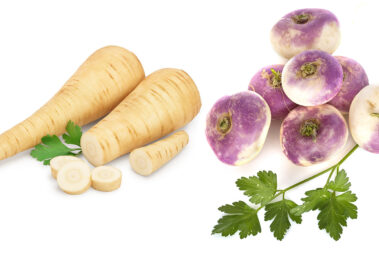If your knowledge of pasta is limited to spaghetti and lasagna, this list is for you. Below, we’ll introduce you to many pasta varieties you’ve never heard of and tell you why they are worth searching out. We’ll also share some lesser-known facts about more popular pasta types to give you a better appreciation for this versatile and delicious food.
Table of Contents
Different Types of Pasta
Angel Hair

Known in Italy as capelli d’angelo, angel hair pasta is a thinner version of capellini, which itself is a thin version of spaghetti. It is often sold woven into a nest shape and is a great choice for adding to soups, for use with seafood dishes, or to enjoy with a light sauce.
Bucatini

To the untrained eye, bucatini is easy to mistake for spaghetti. But if you look closer you will notice this rare type of pasta is a bit thicker than the more popular variety and it has a hole running through the center. This long, hollow noodle has the magic ability to suck up sauce so you can enjoy your pasta not just coated with tomato sauce or olive oil, but infused with it!
Campanelle

In Italian, campanelle means “bell flower” and that’s truly the best way to describe this uncommon noodle’s shape. It is something like a hybrid between a shell and a macaroni with an extra twist. All those nooks and crannies make it the perfect noodle to enjoy with thick sauces like ragu or alfredo.
Cannelloni

Considered a type of lasagna, cannelloni noodles look nothing like their more popular, flatter cousin. These oversized tubes are perfect for stuffing with cheese and veggies and slathering in sauce. Unlike manicotti, the American version of cannelloni, these Italian noodles are smooth and cut flat at the ends.
Casarecce

In Italian, casarecce means “homemade” which gives you a pretty good idea of how this simple noodle came to be. Casarecce noodles look like little rolled-up scrolls and are made by cutting dough into squares and rolling them around with a wooden pin. This pasta can be enjoyed with a variety of sauces but is especially well suited for Sicilian pesto.
Cavatappi

Cavatappi, which means “corkscrew” in Italian, is easily one of the most fun pastas to eat. Depending on the variety, these little noodles can feature one to three full turns, but any less than one, and they become just a twisted version of elbow pasta. Cavatappi is most commonly enjoyed with tomato sauces.
Cavatelli

Cavatelli is a short, hot-dog-bun-shaped noodle that is made of semolina flour or other similar flours. This pasta is fairly easy to make at home and provides a great base for simple sauces like oil, garlic, and broccoli, or oil and cheese.
Conchiglie

More commonly known as shell pasta, this popular noodle variety comes in three different sizes. Conchigliette is the smallest and is common in soups and macaroni and cheese. Conchiglioni is the largest and is often stuffed and baked with sauce. The middle-sized shells are simply called conchiglie and are best paired with a thick sauce.
Ditalini

Ditalini pasta consists of short, stumpy tubes and is commonly used in soups and salads. Also called salad pasta, this easily recognizable noodle is common in Sicily and mass-produced in many countries throughout the world.
Farfalle

In Italian, farfalle means “butterfly,” but these popular noodles are much more commonly known by their English name, bow tie pasta. Farfalle comes in many sizes, all with distinct ruffled edges and pinched centers. These noodles go well with any type of sauce but are most commonly enjoyed with tomato-based and creamy sauces.
Fettuccine

Fettuccine is a well-known, wide, thick pasta made of wheat and egg. It’s most commonly used in Roman and Tuscan cuisine. In Italy, it is eaten most often with various types of ragu sauce. In America, it’s very popular with alfredo.
Fideo

Translated to English, fideo simply means noodle, but the term is used most often in Italy to describe a shorter version of vermicelli. Fideo is a very thin pasta that is highly versatile but best enjoyed with thin sauces or in soup.
Fusilli

Fusilli is often confused with the more popular rotini, but the two types of pasta are actually different in shape and texture. Fusilli is made by twisting a round strand of pasta to create a spring-like shape. It is denser than rotini and best enjoyed with thick cream sauces.
Gemelli

Like the related term, Gemini, gemelli is Italian for “twins.” The term is used to describe this pasta because it looks like two rounded noodles twisted together. In reality, each piece of gemelli is made by taking one long rolled piece of pasta, bending it in half, and rolling it into a helical shape.
Gnocchi

While we often think of gnocchi as a type of noodle here in America, in Italy they are considered dumplings. Unlike true pasta, gnocchi is made with a long list of ingredients including potato, semolina, cheese, and cornmeal. Gnocchi is often served with butter-based sauces but works well in a variety of recipes.
Lasagna

Lasagna noodles are some of the oldest in Italy. This flat pasta was originally enjoyed in the 14th century with a sprinkling of cheese and spices. The more popular layered dish many think of when they hear the word lasagna did not become a thing until many centuries later.
Linguine

Linguine, which means “little tongue” in Italian, is about the size of a spaghetti noodle but flat instead of round. It is thinner than fettuccine and, instead of being uniformly flat side-to-side, features a slightly elliptical shape, hence the name. Linguine is best enjoyed with lighter tomato sauces and pesto.
Macaroni

While most Americans consider elbow pasta and macaroni to be synonymous, the term macaroni actually refers to any type of hollow, tube-shaped pasta. Macaroni can be straight, curved, or spiral.
Mafaldine

This harder-to-find pasta variety resembles lasagna but is only about a centimeter wide. It was named for Princess Mafalda of Savoy and is sometimes called riginette, which means “little queens” in Italian. This dainty ribbon pasta is best prepared with a delicate sauce.
Manicotti

Manicotti, which means “little sleeves” in Italian, is a popular American-Italian pasta. These large, ridged tubes are often enjoyed stuffed and baked. Unlike cannelloni, which are cut flat at the end, manicotti is always cut at an angle.
Mezzelune

Mezzelune is prepared somewhat like a ravioli but looks more like a Chinese dumpling. They are often filled with cheese or vegetables but can be made with potato or meat filling as well. The word mezzelune translates to “half-moon,” in reference to this noodle’s unique shape.
Orecchiette

Small, round, and shaped like an ear, orecchiette pasta is most commonly eaten in Southern Italy. It’s made by flattening small cubes of dough and curving them over the thumb. In the Apulia region from which this pasta originated, these noodles are eaten most often with capers, pork, and broccoli rabe.
Orzo

Orzo may look like a grain of rice but it is actually a type of pasta made from flour. This noodle is used in a variety of dishes from soups and salads to rice pilaf. The name orzo, which simply means “barley” in Italian, is the popular term in English-speaking countries. In Italy, they call this pasta rossini.
Paccheri

This large, tube-shaped pasta has long been enjoyed in the Neopalitine region. At one point, this perfectly sized, hollow pasta even played a crucial role in smuggling Italian garlic across the border into Austria. Today, it’s often enjoyed with garlic heavy sauces which may or may not be a call back to its unique history.
Pappardelle

Pappardelle pasta resembles wide, thin ribbons. These noodles are often sold fresh with fluted edges and arranged in piles, while the egg-based versions can be found dried. Both are great with thin tomato or oil-based sauces.
Penne

Penne pasta was made to resemble the steel nib of the fountain pen, a popular tool at the time of its creation. In fact, the name comes from the Italian word for “pen.” Today, this tubular pasta is popular throughout the world and enjoyed with a variety of sauces and in pasta salads.
Radiatori

With wide, deep ridges, radiatori very much resembles its namesake, the industrialized radiator popular in Europe between the World Wars. Like rotini and fusilli, this noodle is best with thick sauces that can fill the spaces on each piece of pasta.
Ravioli

Ravioli is a widely popular pasta that can be enjoyed in a number of ways. The term is most often used in reference to square noodles but can be used to describe stuffed pasta of any shape from circular to crescent.
Rigatoni

A Sicilian favorite, rigatoni resembles penne pasta but is much larger. They may have a slight curve to them and are typically cut straight at each end. Those deep ridges are good at catching sauce, which makes this pasta especially good for pairing with slick sauces like tomato.
Rotelle

One of the most fun pasta shapes out there, rotelle (or rotelli) is wheel-shaped and usually about the size of a nickel. These noodles have large gaps that are perfect for catching chunks of meat and globes of thick cream sauce. They are also a great choice for adding a little levity to soups and pasta salads.
Rotini

Rotini is a popular, corkscrew-shaped pasta used in a variety of dishes from salads to soups to ragu. While similar to fusilli, rotini has a flatter, more tightly twisted shape.
Spaghetti

Arguably the most popular type of pasta in America, spaghetti is easy to recognize whether it’s covered in traditional tomato sauce or lightly drizzled with olive oil. Spaghetti is also popular in Italy where it became one of the first mass-produced pasta varieties available.
Tagliatelle

Tagliatelle is a traditional egg-based pasta that’s similar in shape to pappardelle but is slightly thinner. This ribbon-like pasta is traditionally paired with bolognese but goes well with a variety of chunky sauces.
Tortellini

Tortellini are small, ring-shaped, stuffed noodles that somewhat resemble a sailor’s hat or belly button. Traditionally, they are stuffed with a meat mix and served in capon broth, but they are equally tasty filled with a vegan cheese and veggie mix and doused in red sauce.
Vermicelli

The term vermicelli refers to slightly different types of pasta depending on where you’re at. In English-speaking regions, the name is reserved for a thinner version of spaghetti. In Italy, vermicelli refers to a round pasta slightly thicker than spaghetti. In either case, this cylindrical noodle is great with any sauce you’d typically put on angel hair or spaghetti.
Ziti

Ziti is similar to penne and other tubular pasta types, but is narrower in shape, has no ridges, and is cut flat at the ends. This noodle is most commonly used in baked ziti, which is traditionally served at weddings. In fact, the word ziti comes from the term zito, Italian for “bride” or “groom.”
Ask an Expert: Where Does Pasta Come From?
Pasta, which is a term that refers specifically to noodles traditionally produced in Italy, has a bit of a muddled history. This is because this popular food has long been eaten by the commoners as well as the royals, meaning there was never any real need to document its use or origin.
Most likely, the idea for pasta came from Asia, where local cultures had been making and consuming noodles for thousands of years. While Marco Polo is popularly credited with bringing pasta to Italy from his travels, it is much more likely that the dish arrived long before he was born via nomadic Arabs, who often traded between Asia and Europe.
Once the idea of noodles came to Italy, the locals refined the production process by using durum wheat, water, and sometimes egg to create a type of noodle with an almost unlimited shelf life. The ability to store pasta for long periods along with its versatility made it an instant favorite throughout the country and, eventually, the world.
FAQ
What is the healthiest type of pasta?
Any type of pasta made with whole wheat is generally the healthiest bet. Traditional pasta is made from refined grains, but many of the classic varieties, including spaghetti, penne, and rotini, can be found in whole-grain form.
What type of pasta is the most unhealthy?
Strictly speaking, any pasta made from refined grains is not great for you. Refined pasta stuffed with cheese, such as ravioli, definitely tops the list as the least healthy option.
What is the most hard-to-find type of pasta?
Su filindeu pasta is easily the rarest and hardest-to-find variety in the world. Only a handful of women in Nuoro, Sardinia, know how to make this intricate pasta.
So Much Pasta to Enjoy!
Suddenly got a hankering for a big bowl of pasta? We’ve got you covered. Below are some of our favorite pasta recipes for every occasion.
- Easy Vegan Summer Pasta Salad – This refreshing cold pasta salad is wonderful with rotini, radiatori, or Gemelli.
- Creamy Avocado Mac And Cheese – Sure macaroni is the go-to noodle for this dish, but I recommend making it with ditalini or conchiglie to really elevate that vegan cheese sauce.
- Vegan Vodka Sauce – This delicious sauce works on a vareity of different past types from cavatappi to bucatini.
- Vegan Eggplant Parmesan – Angel hair and spaghetti are the go-to noodle for this dish, but it also pairs well with vermicelli.
- Pasta Primavera – This awesome recipe calls for Gemelli pasta. I’ve also made it with radiatori and orecchiette with good results.
Love learning about different kinds of food and the great recipes you can make from unique ingredients? Be sure to sign up for our newsletter to get more great content like this delivered weekly.
For the Love of Pasta
There you have it, 36 wonderful types of pasta from the popular to the obscure. Which is your favorite? Let us know in the comments section below.

How to Cook Pasta
Ingredients
- 1 lb pasta dry
- 6 quarts water
- 3 tbsp salt
Instructions
- Pour the water into a large pot and bring to a boil.
- Add the salt to the boiling water and stir, then add the dry pasta.
- Stir carefully, taking care not to break the pasta.
Notes
- When adding pasta to a sauce, try cooking for one minute less than the package instructions. Drain the pasta, but don’t rinse, and then add it to your sauce.
- For a cold pasta salad, cook according to package instructions. Drain the pasta, but don’t rinse, and toss with olive oil. Refrigerate for later use.
- Store cooked pasta in an airtight container in the refrigerator for up to 5 days. Pasta can be easily reheated to enjoy leftovers.
Nutrition
- How to Pick the Perfect Watermelon For a Sweet Summer Treat - April 10, 2024
- Future Kind’s Foundations: A Multivitamin Made for Vegans - December 5, 2023
- Does Nutritional Yeast Go Bad? - November 28, 2023








